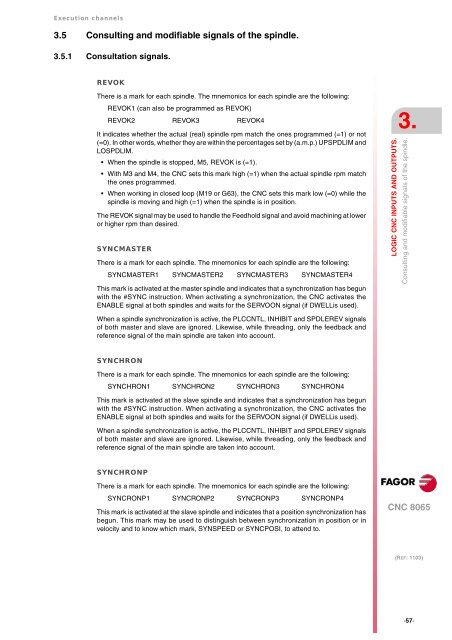EN: man_8065_chn.pdf - Fagor Automation
EN: man_8065_chn.pdf - Fagor Automation
EN: man_8065_chn.pdf - Fagor Automation
Create successful ePaper yourself
Turn your PDF publications into a flip-book with our unique Google optimized e-Paper software.
Execution channels<br />
3.5 Consulting and modifiable signals of the spindle.<br />
3.5.1 Consultation signals.<br />
REVOK<br />
There is a mark for each spindle. The mnemonics for each spindle are the following:<br />
REVOK1 (can also be programmed as REVOK)<br />
REVOK2 REVOK3 REVOK4<br />
It indicates whether the actual (real) spindle rpm match the ones programmed (=1) or not<br />
(=0). In other words, whether they are within the percentages set by (a.m.p.) UPSPDLIM and<br />
LOSPDLIM.<br />
When the spindle is stopped, M5, REVOK is (=1).<br />
With M3 and M4, the CNC sets this mark high (=1) when the actual spindle rpm match<br />
the ones programmed.<br />
When working in closed loop (M19 or G63), the CNC sets this mark low (=0) while the<br />
spindle is moving and high (=1) when the spindle is in position.<br />
The REVOK signal may be used to handle the Feedhold signal and avoid machining at lower<br />
or higher rpm than desired.<br />
SYNCMASTER<br />
There is a mark for each spindle. The mnemonics for each spindle are the following:<br />
SYNCMASTER1 SYNCMASTER2 SYNCMASTER3 SYNCMASTER4<br />
This mark is activated at the master spindle and indicates that a synchronization has begun<br />
with the #SYNC instruction. When activating a synchronization, the CNC activates the<br />
<strong>EN</strong>ABLE signal at both spindles and waits for the SERVOON signal (if DWELLis used).<br />
When a spindle synchronization is active, the PLCCNTL, INHIBIT and SPDLEREV signals<br />
of both master and slave are ignored. Likewise, while threading, only the feedback and<br />
reference signal of the main spindle are taken into account.<br />
SYNCHRON<br />
There is a mark for each spindle. The mnemonics for each spindle are the following:<br />
SYNCHRON1 SYNCHRON2 SYNCHRON3 SYNCHRON4<br />
This mark is activated at the slave spindle and indicates that a synchronization has begun<br />
with the #SYNC instruction. When activating a synchronization, the CNC activates the<br />
<strong>EN</strong>ABLE signal at both spindles and waits for the SERVOON signal (if DWELLis used).<br />
When a spindle synchronization is active, the PLCCNTL, INHIBIT and SPDLEREV signals<br />
of both master and slave are ignored. Likewise, while threading, only the feedback and<br />
reference signal of the main spindle are taken into account.<br />
SYNCHRONP<br />
There is a mark for each spindle. The mnemonics for each spindle are the following:<br />
SYNCRONP1 SYNCRONP2 SYNCRONP3 SYNCRONP4<br />
This mark is activated at the slave spindle and indicates that a position synchronization has<br />
begun. This mark may be used to distinguish between synchronization in position or in<br />
velocity and to know which mark, SYNSPEED or SYNCPOSI, to attend to.<br />
3.<br />
LOGIC CNC INPUTS AND OUTPUTS.<br />
Consulting and modifiable signals of the spindle.<br />
CNC <strong>8065</strong><br />
(REF: 1103)<br />
·57·
















